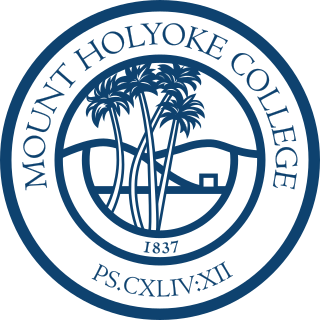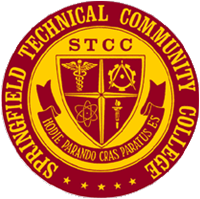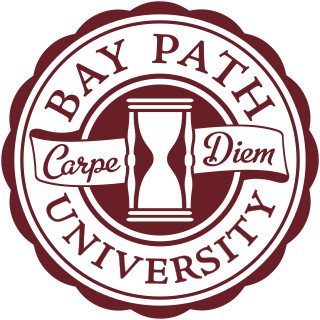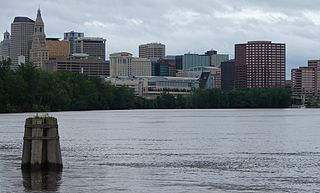
Hampden County is a non-governmental county located in the Pioneer Valley of the U.S. state of Massachusetts, in the United States. As of the 2020 census, Hampden County's population was 465,825. Its traditional county seat is Springfield, the Connecticut River Valley's largest city, and economic and cultural capital; with an estimated population of 154,758, approximately one-third of Hampden County residents live in Springfield.

Springfield is the most populous city in and the seat of Hampden County, Massachusetts, United States. Springfield sits on the eastern bank of the Connecticut River near its confluence with three rivers: the western Westfield River, the eastern Chicopee River, and the eastern Mill River. At the 2020 census, the city's population was 155,929, making it the third most populous city in the U.S. state of Massachusetts and the fourth most populous city in New England after Boston, Worcester, and Providence. Metropolitan Springfield, as one of two metropolitan areas in Massachusetts, had a population of 699,162 in 2020.

Mount Holyoke College is a private women's liberal arts college in South Hadley, Massachusetts, United States. It is the oldest member of the historic Seven Sisters colleges, a group of historically female colleges in the Northeastern United States. The college was founded in 1837 as the Mount Holyoke Female Seminary by Mary Lyon, a pioneer in education for women. Mount Holyoke is part of the Five College Consortium in Western Massachusetts.

Holyoke is a city in Hampden County, Massachusetts, United States, that lies between the western bank of the Connecticut River and the Mount Tom Range. As of the 2020 census, the city had a population of 38,247. Located 8 miles (13 km) north of Springfield, Holyoke is part of the Springfield Metropolitan Area, one of the two distinct metropolitan areas in Massachusetts.

Westfield is a city in Hampden County, in the Pioneer Valley of western Massachusetts, United States. Westfield was first settled by Europeans in 1660. It is part of the Springfield, Massachusetts Metropolitan Statistical Area. The population was 40,834 at the 2020 census.

The Five College Consortium comprises four liberal arts colleges and one university in the Connecticut River Pioneer Valley of Western Massachusetts: Amherst College, Hampshire College, Mount Holyoke College, Smith College, and the University of Massachusetts Amherst, totaling approximately 38,000 students. They are geographically close to one another and are linked by frequent bus service that operates between the campuses during the school year.

The Pioneer Valley is the colloquial and promotional name for the portion of the Connecticut River Valley that is in Massachusetts in the United States. It is generally taken to comprise the three counties of Hampden, Hampshire, and Franklin. The lower Pioneer Valley corresponds to the Springfield, Massachusetts metropolitan area, the region's urban center, and the seat of Hampden County. The upper Pioneer Valley region includes the smaller cities of Northampton and Greenfield, the county seats of Hampshire and Franklin counties, respectively.

The University of Massachusetts is the five-campus public university system in the Commonwealth of Massachusetts. The university system includes six campuses, a satellite campus in Springfield and 25 smaller campuses throughout California and Washington with the University of Massachusetts Global.
A consortium is an association of two or more individuals, companies, organizations, or governments with the objective of participating in a common activity or pooling their resources for achieving a common goal.

Western Massachusetts, known colloquially as "western Mass," is a region in Massachusetts, one of the six U.S. states that make up the New England region of the United States. Western Massachusetts has diverse topography; 22 colleges and universities including UMass in Amherst, MA, with approximately 100,000 students; and such institutions as Tanglewood, the Springfield Armory, and Jacob's Pillow.

Holyoke Community College (HCC) is a public community college in Holyoke, Massachusetts. It offers associate degrees and certificate programs, as well as a transfer program for students to earn credits for transfer to other colleges. It was the first community college established in Massachusetts, as it was founded by the city's school board in 1946, while others were subsequently chartered under state jurisdiction after 1960.

Western New England University is a private university in Springfield, Massachusetts. Academic programs are provided through its College of Arts and Sciences, College of Business, College of Engineering, School of Law, and College of Pharmacy and Health Sciences.

Springfield Technical Community College is a public technical college in Springfield, Massachusetts. It is the only technical community college in the Commonwealth of Massachusetts. Located on the site of the Springfield Armory National Park, which was founded by Henry Knox and George Washington during the Revolutionary War, Springfield Technical Community College now occupies many of the buildings used by the U.S. Armory at Springfield prior to the Armory's closure in 1969. While 20 acres (81,000 m2) of the 55-acre (220,000 m2) site remain in the hands of the U.S. National Park Service for historic preservation, 35 acres (140,000 m2) comprise the college campus. Numerous historic buildings have been repurposed as classrooms, in addition to newer facilities built on-site.
Cambridge College is a private college based in Boston, Massachusetts. It also operates regional centers in Lawrence, Massachusetts, Springfield, Massachusetts, Guaynabo, Puerto Rico, and Rancho Cucamonga, California. There is also a regional center in Memphis, Tennessee.

Bay Path University is a private university in Longmeadow, Massachusetts, United States. Bay Path offers both all-women bachelor's degree programs and co-educational graduate programs.

The greater Hartford–Springfield area is an urban region and surrounding suburban areas that encompasses both north-central Connecticut and the southern Connecticut River Valley in western Massachusetts; its major city centers are Springfield, Massachusetts and Hartford, Connecticut.

The Springfield metropolitan area, also known as Greater Springfield, is a region that is socio-economically and culturally tied to the City of Springfield, Massachusetts. The U.S. Office of Management and Budget defines the Springfield, MA Metropolitan Statistical Area (MSA) as consisting of three counties in Western Massachusetts. As of 2023, the metropolitan area's population was estimated at 460,291, making it the 117th-largest metropolitan area in the United States.

During the late 19th and early 20th centuries Holyoke saw an influx of Franco-Americans, predominantly French-Canadians, who immigrated to Massachusetts to work in the city's growing textile and paper mills. By 1900, 1 in 3 people in Holyoke were of French-Canadian descent, and a 1913 survey of French Americans in the United States found Holyoke, along with other Massachusetts cities, to have a larger community of French or French-Canadian born residents than those of New Orleans or Chicago at that time. Initially faced with discrimination for the use of their labor by mill owners to undermine unionization, as well as for their creation of separate French institutions as part of the La Survivance movement, this demographic quickly gained representation in the city's development and civic institutions. Holyoke was at one time a cultural hub for French-Canadian Americans; the Saint-Jean-Baptiste Society of America was first organized in the city in 1899, along with a number of other institutions, including theater and drama societies from which famed vaudevillian Eva Tanguay was first discovered, and regular publications, with its largest French weekly newspaper, La Justice, published from 1904 to 1964. The city was also home to author Jacques Ducharme, whose 1943 book The Shadows of the Trees, published by Harper, was one of the first non-fiction English accounts of New England's French and French-Canadian diaspora.

From the beginning of the city's history as the western bank of Springfield, Irish families have resided in and contributed to the development of the civics and culture of Holyoke, Massachusetts. Among the first appellations given to the city were the handles "Ireland", "Ireland Parish", or "Ireland Depot", after the village was designated the 3rd Parish of West Springfield in 1786. Initially occupied by a mixture of Yankee English and Irish Protestant families, many of whom belonged to the Baptist community of Elmwood, from 1840 through 1870 the area saw a large influx of Irish Catholic workers, immigrants to the United States, initially from the exodus of the Great Famine. During that period Irish immigrants and their descendants comprised the largest demographic in Holyoke and built much of the early city's infrastructure, including the dams, canals, and factories. Facing early hardships from Anti-Irish sentiment, Holyoke's Irish would largely build the early labor movement of the city's textile and paper mills, and remained active in the national Irish nationalist and Gaelic revival movements of the United States, with the Holyoke Philo-Celtic Society being one of 13 signatory organizations creating the Gaelic League of America, an early 20th century American counterpart of Conradh na Gaeilge.
As of the 2010 United States Census, there were 39,880 people, 15,361 households, and 9,329 families residing in the city of Holyoke, Massachusetts. The population density was 723.6/km2 (1,874/mi²). There were 16,384 housing units at an average density of 277.2/km2 (718.6/mi²).


















